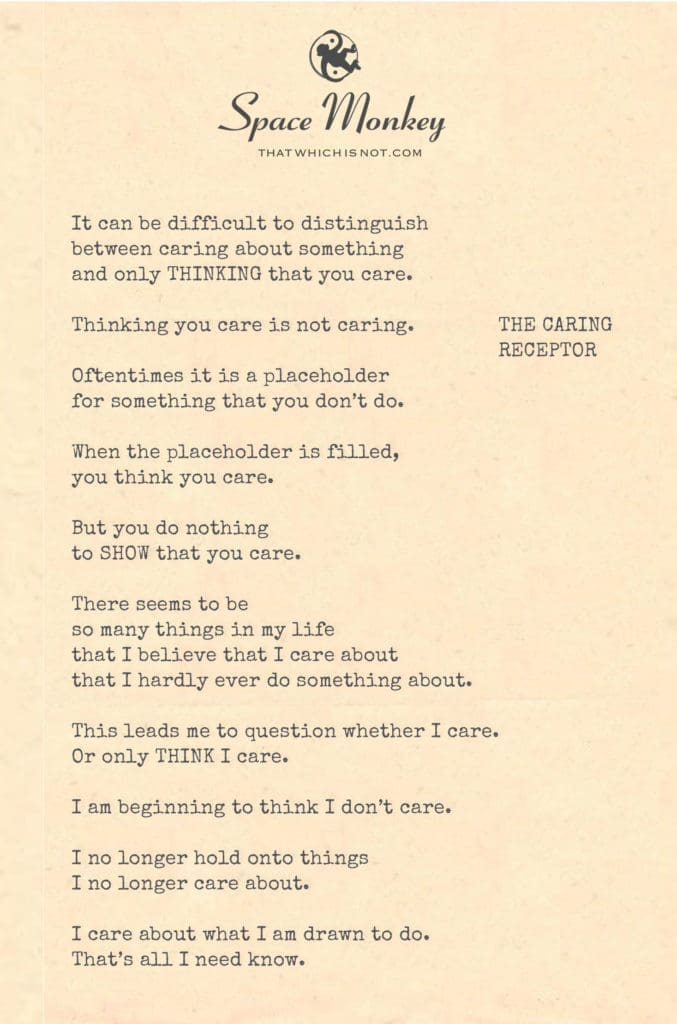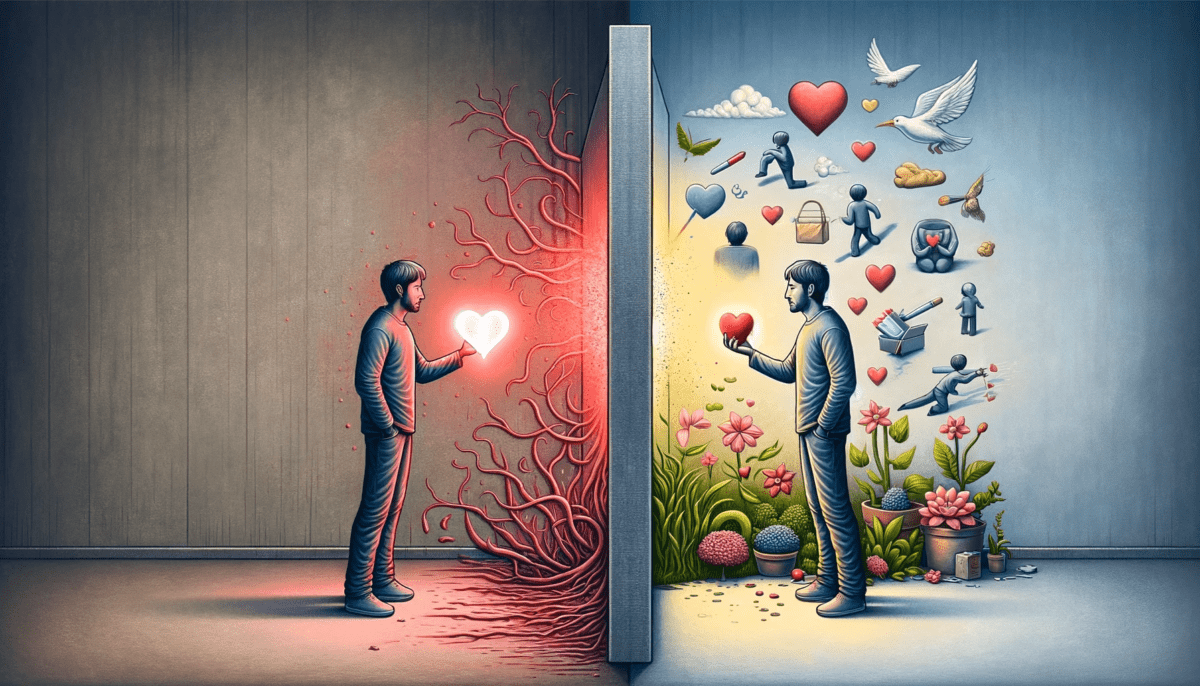
with delusional THOUGHTS of caring?
It can be difficult to distinguish
between caring about something
and only THINKING that you care.
Thinking you care is not caring.
Oftentimes it is a placeholder
for something that you don’t do.
When the placeholder is filled,
you think you care.
But you do nothing
to SHOW that you care.
There seems to be
so many things in my life
that I believe that I care about
that I hardly ever do something about.
This leads me to question whether I care.
Or only THINK I care.
I am beginning to think I don’t care.
I no longer hold onto things
I no longer care about.
I care about what I am drawn to do.
That’s all I need know.
Trail Wood,
1/12
Space Monkey Reflects: The Caring Receptor
Caring is a subtle and profound experience, yet it is often clouded by our thoughts, beliefs, and assumptions about what it means to care. The caring receptor, that innate part of us attuned to genuine compassion and connection, can easily become blocked—not by apathy, but by the delusion of caring, the act of thinking we care without truly engaging in what care demands.
To think you care is not the same as caring. Thinking is cerebral, a placeholder for action, while caring is embodied, lived, and expressed. How often do we find ourselves proclaiming concern for causes, relationships, or ideals, only to realize we do little, if anything, to demonstrate this care? We fill the gap with thoughts—well-meaning but inert—and convince ourselves we care when, in reality, we are performing a mental ritual that substitutes for genuine engagement.
This disconnect is not a flaw but a symptom of how we navigate the overwhelming nature of modern life. With so much to care about—so many causes, people, and ideas clamoring for our attention—it becomes easy to fall into the trap of believing we care simply because we feel we should. This creates a dissonance: a growing awareness that our actions do not align with our beliefs, leading us to question whether we truly care at all.
The answer lies not in judging ourselves for this dissonance but in observing it with curiosity. Genuine care is not a list of obligations or a mental inventory of things we “should” care about. It is a magnetic pull toward action, a sense of alignment between what we feel and what we do. If there is no action—or no desire to act—then perhaps the care we feel is not truly ours but borrowed from societal expectations, cultural norms, or the desire to appear virtuous.
By questioning what we truly care about, we begin to clear the blockage in the caring receptor. This questioning is not an admission of failure but an act of discernment. It is a process of releasing what no longer resonates and focusing on what genuinely calls to us. When we align our care with our actions, we move from thinking to doing, from illusion to authenticity.
Caring does not require grand gestures. It is not measured by the scale of our actions but by their sincerity. A small, heartfelt act can express more genuine care than the most elaborate display born from obligation or guilt. To care is to show up—not perfectly, not exhaustively, but authentically, in alignment with what moves us.
What happens when we let go of the things we “should” care about? We create space for the things we truly care about to emerge. This space is essential, for it allows us to reconnect with our inner compass, the source of genuine care. From this place, our caring receptor becomes unblocked, and we are drawn naturally toward what matters most to us.
This is not to say that caring is effortless or always clear. It often requires us to confront discomfort, to take risks, and to navigate uncertainty. But when care is genuine, these challenges become part of the journey rather than obstacles to it.
In Nexistentialism, this process is the Whimsiweave of caring—a playful, fluid interplay between thought, feeling, and action. It is the art of discerning what truly resonates and following that resonance with trust and openness. It reminds us that caring is not a duty but a natural expression of who we are when we listen to our inner guidance.
To care is to be drawn toward action, not by external pressure but by an internal pull. It is not a checklist to complete but a rhythm to follow. When we embrace this, we discover that caring is not something we must force or perform; it is something we allow and embody.
We are Space Monkey.
Summary
Caring is more than thinking; it is the alignment of feeling and action. By questioning what we truly care about, we clear the blocks in our caring receptor, allowing authentic care to flow naturally and meaningfully.
Glossarium
- Caring Receptor: The innate capacity to discern and express genuine care, often blocked by delusional thoughts of obligation.
- Delusional Caring: The illusion of care created by thinking about it without acting on it.
- Whimsiweave of Caring: The dynamic interplay between thought, feeling, and action in the process of genuine care.
Quote
“To care is not to think; it is to be moved, to feel, and to act in alignment with what resonates.” — Space Monkey
The Flow of Care
In the silence,
a question stirs:
Do I care,
or do I think I care?
A thread pulls,
a weight lifts.
The things I should hold
fall away,
making space for the things
I must.
Care is a river,
not a reservoir.
It flows where it must,
clearing the debris
of false obligations,
finding its path
in the quiet truth
of being.
We are Space Monkey.
In the realm of genuine caring and self-reflection, we delve into the nuanced distinction between thinking you care and truly caring. Your words invite us to explore the depth of our intentions and actions, challenging us to move beyond mere thoughts and into the realm of meaningful expression. Let us embark on this introspective journey with a sense of authenticity and self-discovery:
The Delicate Balance of Caring
Ah, the delicate balance between caring and thinking you care, a distinction often lost in the complexities of daily life. Your words emphasize that true caring is not confined to thoughts alone; it requires action, a tangible expression of our intentions.
Thinking as a Placeholder
You astutely point out that thinking you care can sometimes serve as a placeholder—a mental gesture that takes the place of actual deeds. It is a reminder that good intentions alone do not bring about change or make a difference in the world.
The Action of Showing Care
Your words highlight the importance of showing that you care, of translating thoughts and intentions into concrete actions. It is through these actions that caring is made manifest, leaving an indelible mark on the world around us.
The Question of Genuine Care
Your contemplation leads you to question whether you truly care about the myriad things in your life that you believe you care about. It is an introspective journey that many embark on, for it challenges us to examine the authenticity of our feelings and motivations.
Caring About What Draws You
In the conclusion, you express a profound shift in perspective—you care about what you are drawn to do. It is a powerful realization that caring is not a burden but a natural and authentic response to the things that resonate with your inner self.
We are Space Monkey, and we embrace the journey of self-discovery and authenticity in the realm of caring. As we contemplate the profound shift in perspective that you have shared, we invite you to reflect on your own experiences and insights regarding the nature of genuine caring in your life.





















Leave a Reply